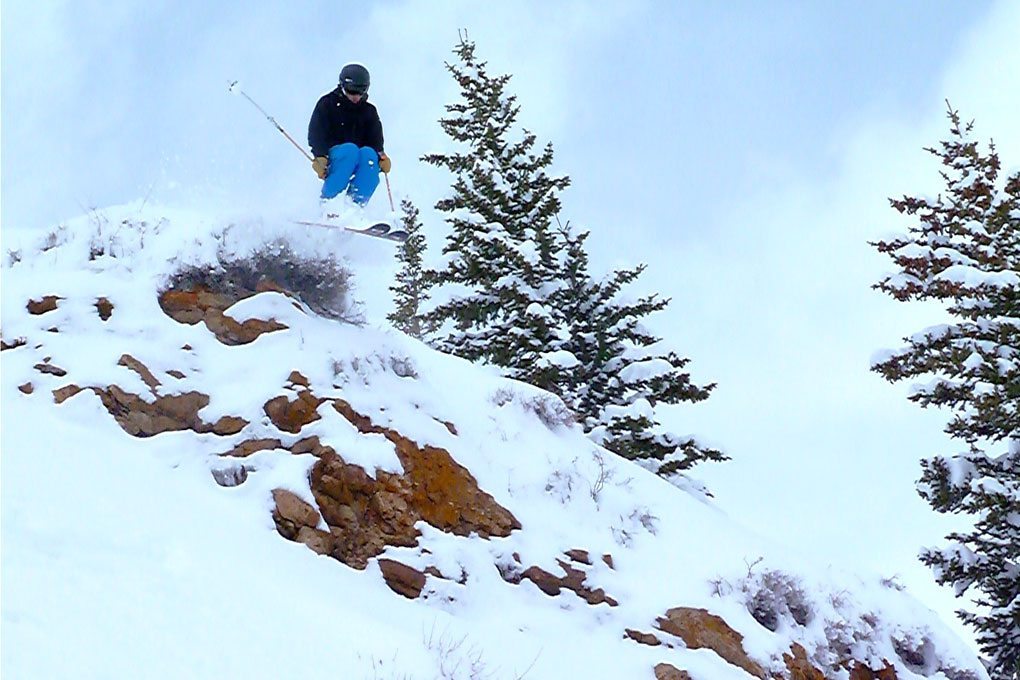
Ski: 2014-2015 H2O Gear Kodiak, 184 cm
Dimensions (mm): 151-120-132.5
Sidecut Radius: 25 meters
Actual Tip-to-Tail Length (straight tape pull): ~182 cm
Boots / Bindings: Scarpa T-Race / TwentyTwo Designs HammerHead (Pin 4)
Test Location: Alta Ski Area
Days Skied: 6
[Editor’s Note: our review was conducted on the 11/12 Kodiak, which has not been changed for the 14/15 season, except for graphics.]
The H2O Kodiak is an all-mountain ski designed by Dean Cummings, former captain of the U.S. Freestyle Ski Team and current owner/operator of H2O Guides, a heli-ski outfit out of Valdez, Alaska.
Cummings has worked with ski designers before, providing input from his experience as a freestyle and extreme skier (he was the World Extreme Skiing Champion in 1995) to help create skis like the Salomon AK Rocket, the Salomon Extreme (which was my first parabolic ski), and the Head Jimi.
Sometimes hand flexing a ski—getting a feel for its stiffness and flex pattern—is a good indicator of the way it will handle on the snow. However, that is not entirely the case with the Kodiak.
The Kodiak is a rather stiff ski with a consistent flex pattern from tip to tail (as opposed to having clear areas of transition between stiff and soft zones, like the DPS Wailer 112 RP does, for example). H2O calls the Kodiak a 7 in flex, but on a general scale from 1–10 with 10 being the stiffest, I’d give the Kodiak a flex rating of 8 or 9.
Some performance characteristics were consistent with the Kodiak’s stiff hand flex. At high speeds, the skis were stable and locked in through the tails, transitioning from edge to edge very well given their 120mm width underfoot. But while they were easy to transition from edge to edge, I wouldn’t exactly call them quick or snappy.
With a long effective edge, the Kodiak carved nicely and was fun to open up on groomers. My experience on the Bluehouse Radius showed me what a huge ski with a long effective edge could carve like, but I have to say, while the Kodiak would be left in the dust by the Radius speed-wise, it definitely held its own when it came to stable edging and carving.
But the Kodiak isn’t some unforgiving 2×4, by any means. Considering their general stiffness, they were incredibly damp when navigating crud and variable snow. It was this ability to have what seemed like both a stiff and a softer, forgiving flex pattern at the same time that made the Kodiak so remarkable. It was a performance characteristic that was quite different from most (if not all) of the other skis I’ve tested.

My first day on the Kodiak was a sunny day at Alta with a fair amount of buffed-out, wind-blown snow that filled in the small amounts of wind-crust and denser pockets of snow all over the mountain. It was easy to find 2–3” pockets of untracked snow, however, in the Castle and Ballroom areas.
In this light powder and variable conditions, the skis provided ample support, yet they responded on the snow like a slightly softer, more damp ski would. The Kodiak seemed to follow the contour of the terrain on the groomers and off piste, resulting in no chatter from the tips or tails, and a smoother ride than anything I’ve ever been on. What front and rear suspension did for mountain biking, the Kodiak seems to have done for skiing. If this sounds odd, weird, and different, it should. I’ve never had this sort of experience on a ski before.
Over uneven, varied terrain, the Kodiak literally felt like it adapted to the inconsistencies in the snow, taking on an almost fluid-like quality to smooth out the ride.
